
Hyundai’s range-topping Ioniq 9 EV moves the brand further upmarket with its poshest, most stylish model yet. It fulfils the brief of a seven-seat all-electric SUV better than any other – including the Kia EV9, with which it shares much of its tech. The battery is bigger for starters, 110kWh for the Hyundai versus the Kia’s 100kWh, meaning the range is slightly better at 385 miles rather than the Kia’s 349 miles.
The Ioniq 9’s £64,995 starting price undercuts the Kia, although it’s nip and tuck as you move up the range, with the truly luxurious Calligraphy models topping out at £78,530, a shade above the current top-spec EV9. But as much as I love the big Kia, it’s the Hyundai that would get my vote, and not only for the bigger battery and longer range.
My first drive of an Ioniq 9 in Korea revealed a car that drives really nicely, feeling comfortable over bumps – and the Korean roads I drove on back then aren’t that different to those in the UK. I was impressed by the refinement on board as well – the Ioniq 9 is super-quiet inside thanks to the double-glazed windows of my test car.
Having now driven the car extensively in the UK, that all still holds true, although the bigger 21in wheels of the Calligraphy model I drove over here gave a slightly firmer edge to the ride.
You can decide whether you prefer the looks of the Ioniq 9 to the Kia EV9, but despite the roofline sloping down towards the back on the Hyundai, there’s still decent headroom in row three, while the middle row will slide to free up more legroom if needed. With deep windows it feels spacious and airy, with good visibility for the driver, too.
I’ve no doubt that this will be another Hyundai that takes sales from many more premium models including the likes of Volvo and Land Rover.
How we test
I spent a week in the UK with the Ioniq 9, taking it on long motorway jaunts, trips to the local supermarket and even a couple of airport runs with loads of luggage on board. While I also rode in the back, I got my family involved, too, playing with the various seating configurations and testing the tech. This was my second drive of the Ioniq 9 after a secret prototype drive near Hyundai’s HQ in Namyang, South Korea, while I also managed to crawl all over the Ioniq 9 at the car’s reveal in Los Angeles at the end of last year.
Hyundai Ioniq 9: From £64,995, Hyundai.com
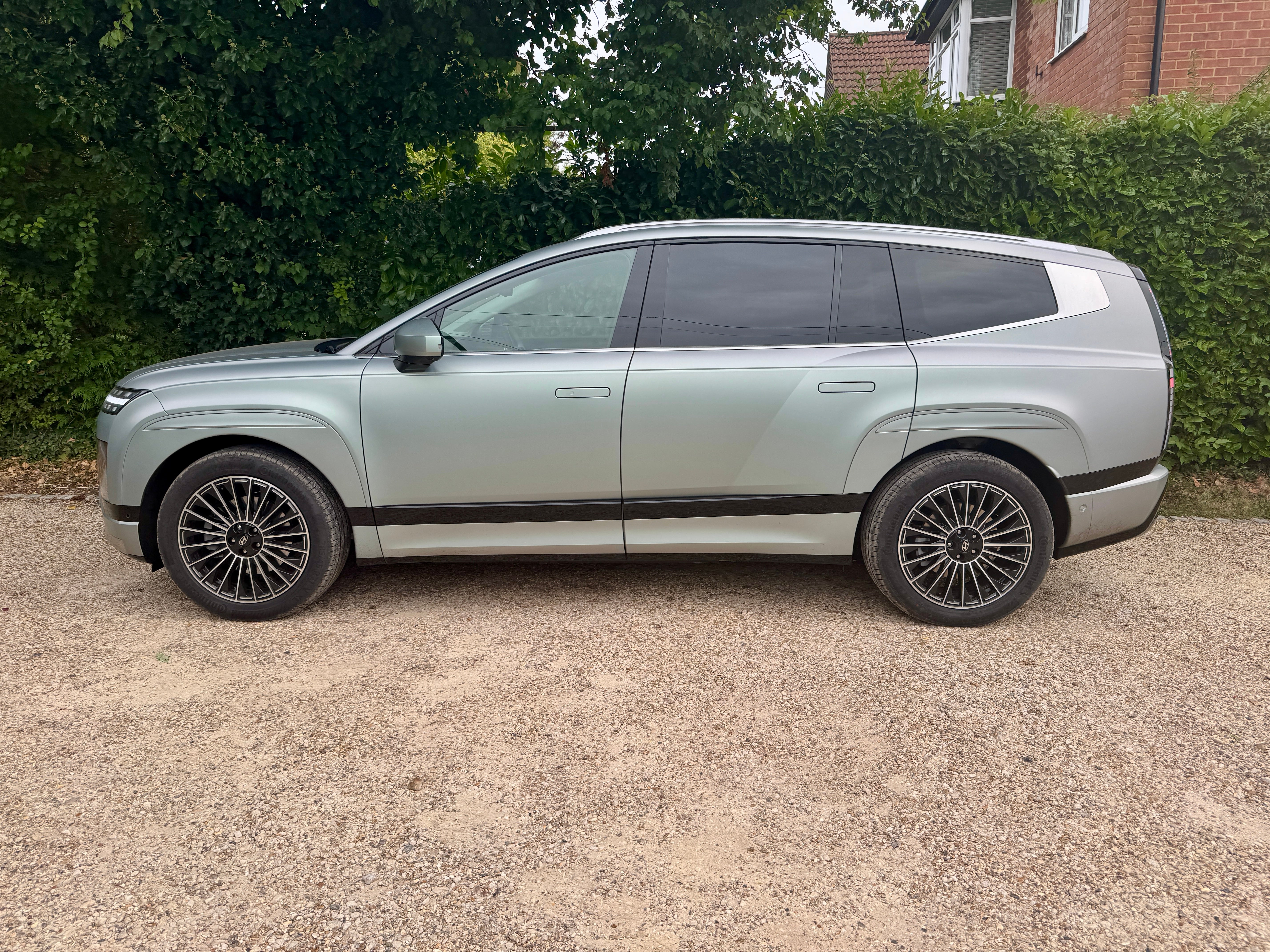
Independent rating: 9/10
- Pros: Long range, ride comfort, interior space, advanced tech
- Cons: Firmer ride on bigger wheels
Hyundai Ioniq 9 specs
- Price range: £64,995 to £78,595
- Battery size: 110 kWh
- Range: 385 miles
- Miles per kWh: TBC
- Maximum charge rate: 233 kW
Battery, range, charging and performance
The 110kWh battery in the Hyundai Ioniq 9 is bigger than that in the Kia EV9 meaning it’ll go further – Hyundai is claiming a range of 385 miles for the Long Range Rear-Wheel Drive model. My top-spec Long Range All-Wheel Drive car in Calligraphy trim gets high-powered twin motors – one on the front axle and one on the back – but still claims a range of 372 miles. Over a week of mixed driving, I reckon around 360 miles is easily achievable.
Although all Ioniq 9s get the same 110kWh battery, there are different versions with different motors offering different power outputs. The entry level car that boasts the longest range gets a single motor for rear-wheel drive and 215bhp, meaning a leisurely but perfectly acceptable 0-62mph time of 9.4 seconds. This car is badged Premium and costs £64,995.
For £73,495 or £75,795 you can get Ultimate or top-spec Calligraphy models (we suspect most people will just go for the latter) with twin motors producing 303bhp and four-wheel drive. They’ll get from 0-62mph in just 6.7seconds.
Then there’s the Performance versions in Calligraphy spec, like the Ioniq 9 I had in the UK, which ups the power to 421bhp through twin motors, giving a frankly rather pointless (in a big SUV) 0-62mph time of 5.2 seconds – faster than the original Lamborghini Countach.
Charging speeds are similarly swift thanks – in part – to the 800-volt platform that the Ioniq 9 makes use of. On a suitable fast charger, you should be able to get up to 233kW, which means a 10 to 80 per cent charge should take around 24 minutes.
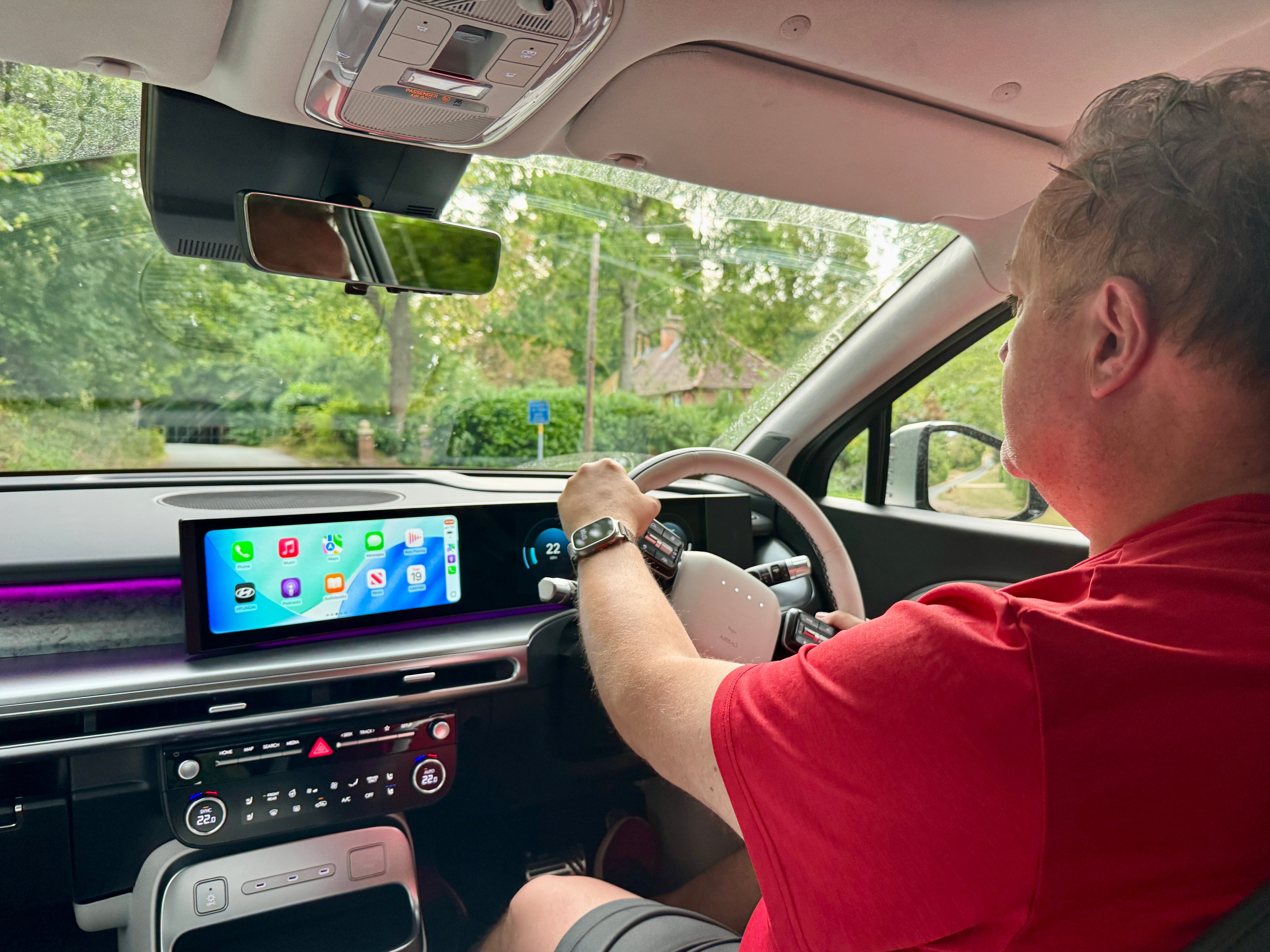
On my many drives including from London to the Midlands, on the motorways around London’s Heathrow Airport, and the lanes and village roads near my home, I was impressed with how comfortable the Ioniq 9 feels. Even over the worst bumps the ride was soft enough – more so than an EV9 – even though my Calligraphy model had the biggest 21in wheels and tyres. I suspect my pick would still be the Calligraphy model but without the Performance powertrain, although I might be tempted by the Ultimate model on 20in wheels, which should be ride a little softer.
Acceleration was smooth and swift, while the level of refinement inside the car was very good, thanks to double-glazed windows, tyres with foam inside for sound deadening and an active noise cancelling system on board, too.
The steering felt accurate and nicely weighted to balance the feeling of control on the move and manoeuvrability around car parks. The car does feel big, but visibility out – plus the help of numerous cameras that can include digital side mirrors with seven-inch screens just inside the doors – makes parking relatively easy.
There’s also clever tech underneath the car – Hyundai calls it a Chassis Domain Control Unit – that uses torque vectoring to improve handling (although this isn’t a sports car), while there’s also Lateral Wind Stability Control to to improve high-speed stability. In our experience, the car would lean if you pushed it hard through corners, which you’re unlikely to do anyway with the family on board.
Our car had eco, normal, sport, snow and me (for personalisation) driving modes, while there’s also an Auto Terrain Mode that uses AI to recognise the road surface and select the perfect driving mode.
Interior, practicality and boot space
Hyundai’s design team has done a great job of disguising the Ioniq 9’s size from the outside – it’s actually marginally bigger than the Kia EV9 but doesn’t look it. The ‘coke bottle’ rear end narrows towards the back, yet the third row of seats still feel really spacious with enough leg and head room for adults to sit in reasonable comfort. Deep windows enhance the feeling of spaciousness inside.
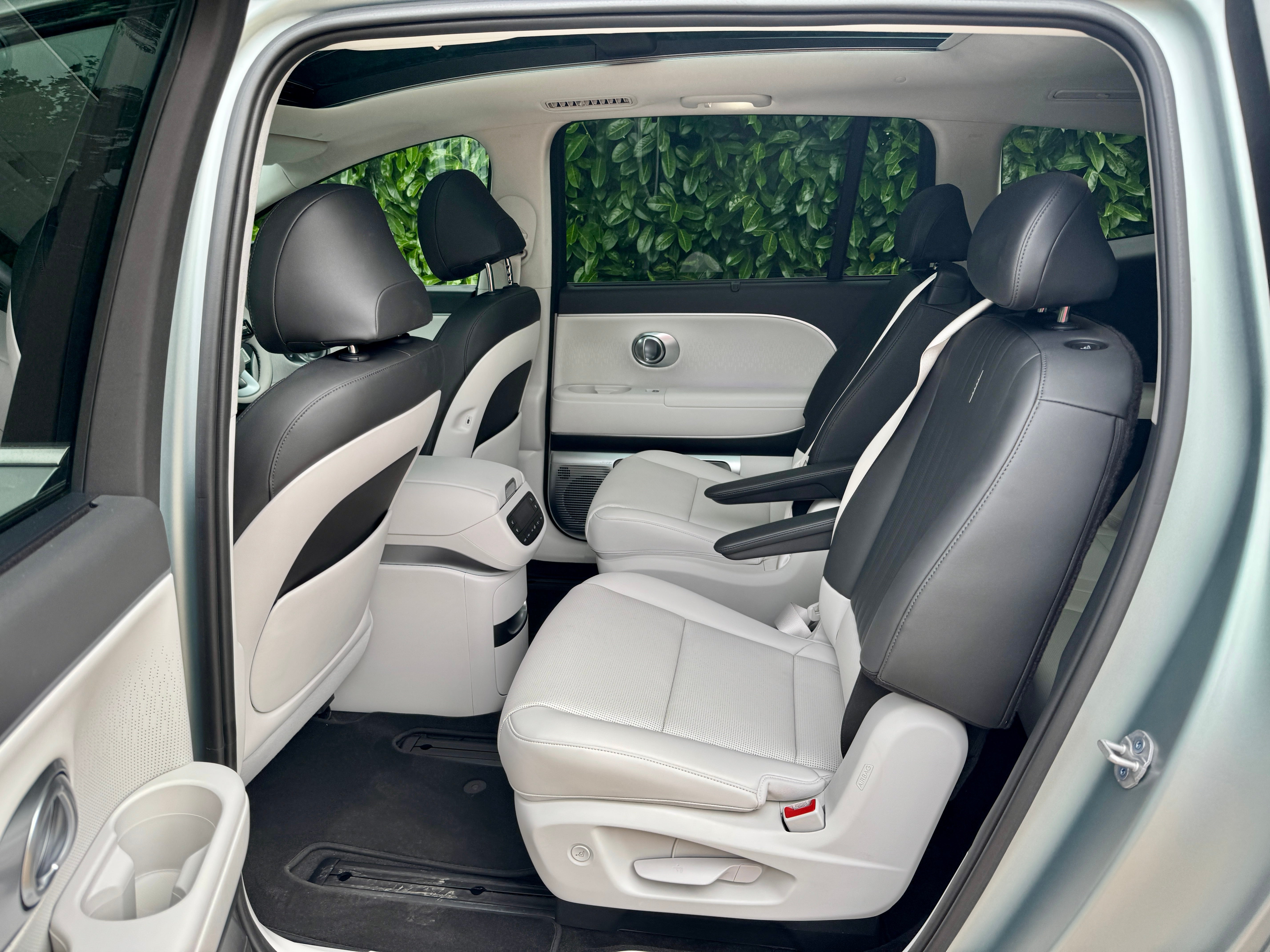
I’m not sure many will go for the optional swivelling seats I had in my six-seat Calligraphy model (which actually costs £1,000 more than the equivalent seven seater – go figure!) but everyone will be impressed by the quality of the materials used throughout the cabin, most with a strong sustainability story, while there are numerous storage spaces for everyone. There’s even a novel Universal Island – a sliding storage unit with 18.2 litres of space inside that can move back and forwards so those in the front or second row can use it.
I found the driver’s seat particularly comfortable and liked the little ‘easter egg’ you have to hunt for – a plus sign on the accelerator and a minus sign on the brake. Middle row passengers were very happy with the space, view and gadgets they had access to, while I had no complaints in the third row – and I’m not the size of a natural third row passenger!
What is perhaps the most impressive thing inside the Ioniq 9 is the style and the quality. This looks and feels like a really upmarket car – as it should at the price. But the light colour palette used in my test car gave the car a really enjoyable and relaxing feeling inside.
At the very back, the rear door opens usefully wide and high to allow excellent access to the boot with an impressive 620 litres of space when all three rows of seats are in use. Fold the third row and that increases to 1,323 litres, while there’s an added 88 litres of space under the bonnet in the frunk.
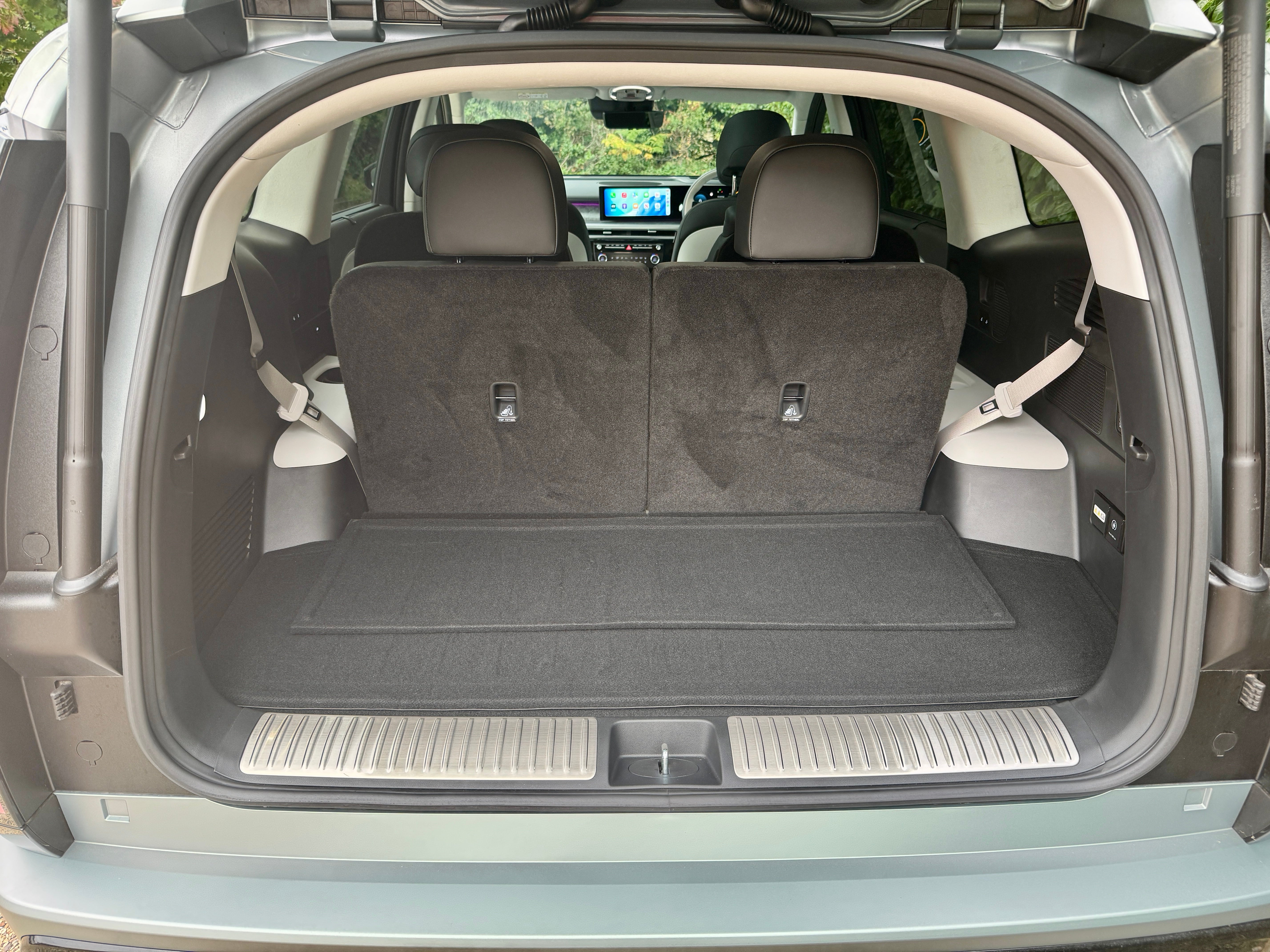
Technology, stereo and infotainment
As with the other Ioniq models, there are twin 12in displays perfectly joined and curving around the driver – one is for driver information, the other for infotainment.
We were delighted to see physical buttons, too, with separate controls for heating and ventilation rather than relying on the touchscreen for everything – there are even heating controls for those in the back.
Software-over-the-air updates will keep everything current, while Features on Demand (FoD) will mean you can buy additional gadgets like lighting effects and content streaming. Wireless Apple CarPlay and Android Auto are standard, as is wireless phone charging, plus myriad USB sockets dotted around the car.
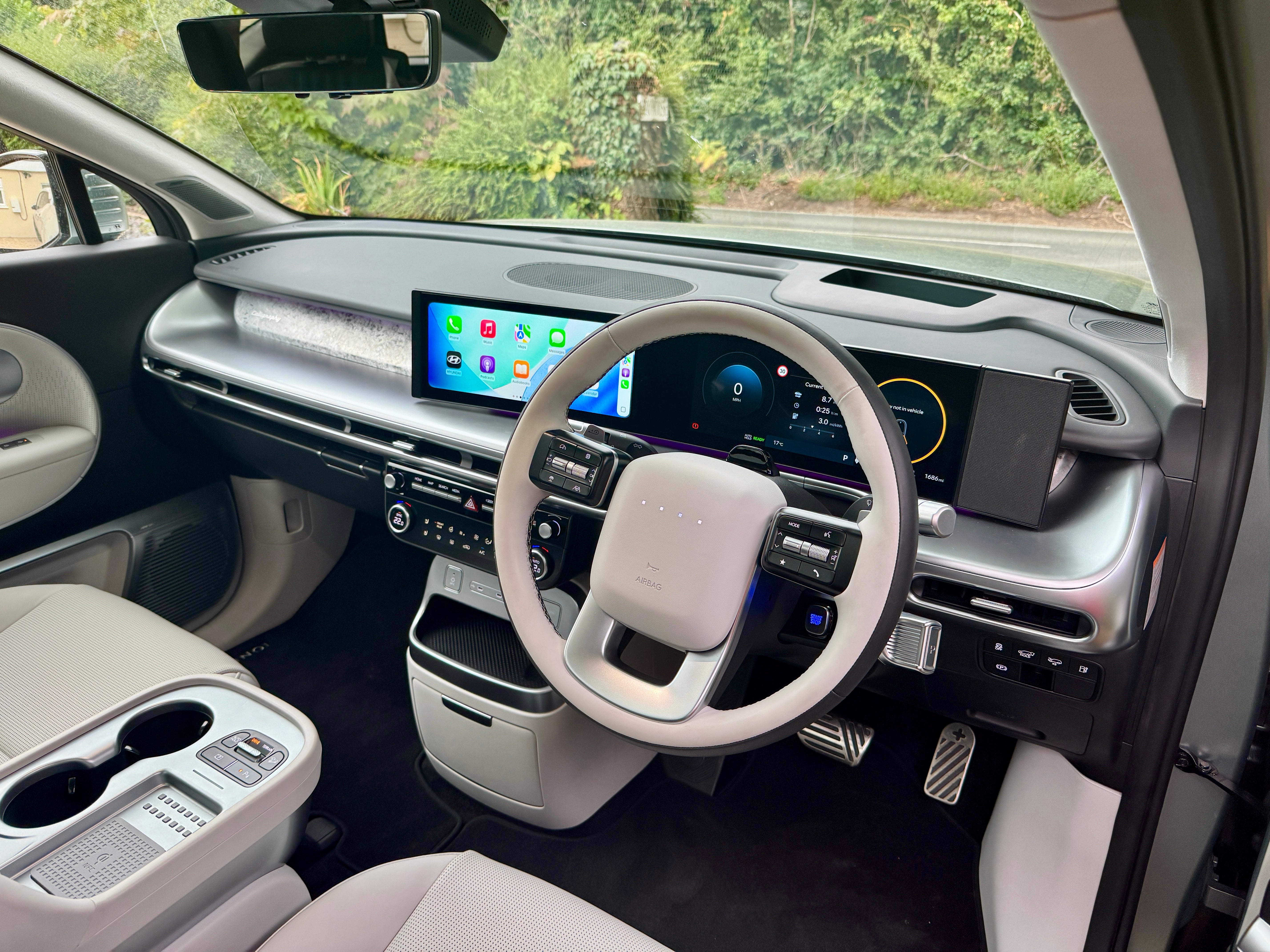
In true Bose fashion, the audio system was powerful and bass heavy, lacking a bit in detail. The sound system also takes care of the car’s noise cancellation feature.
There’s all the luxury and driver assistance features you could wish for, with adaptive cruise control that always works well in Hyundai models (it’s easy to use and trustworthy), while some of the advanced kit includes UV lights in one of the cubbies that supposedly can clean your devices!
Prices and running costs
Prices for the Ioniq 9 run pretty much alongside its sister car, the Kia EV9, with a slight advantage to the Hyundai. That’s impressive given it’s the newer and better car.
You can start with the £64,995 Premium model, although we suspect most people will step up to one of the four-wheel drive models that don’t lose out too much on range. I’d recommend the £75,795 Calligraphy model rather than the £73,495 Ultimate version. Or you can go for one of the Calligraphy cars with the Performance powertrain for £77,595 for seven seats or £78,595 for the six seater with swivelling ‘Captain’s’ chairs in the middle row.
I was impressed by the efficiency on my test drive, with my top-spec Performance powertrain model getting around 360 miles on a full charge – further proof that Hyundai (and Kia) models tend to be more realistic than most on range claims.
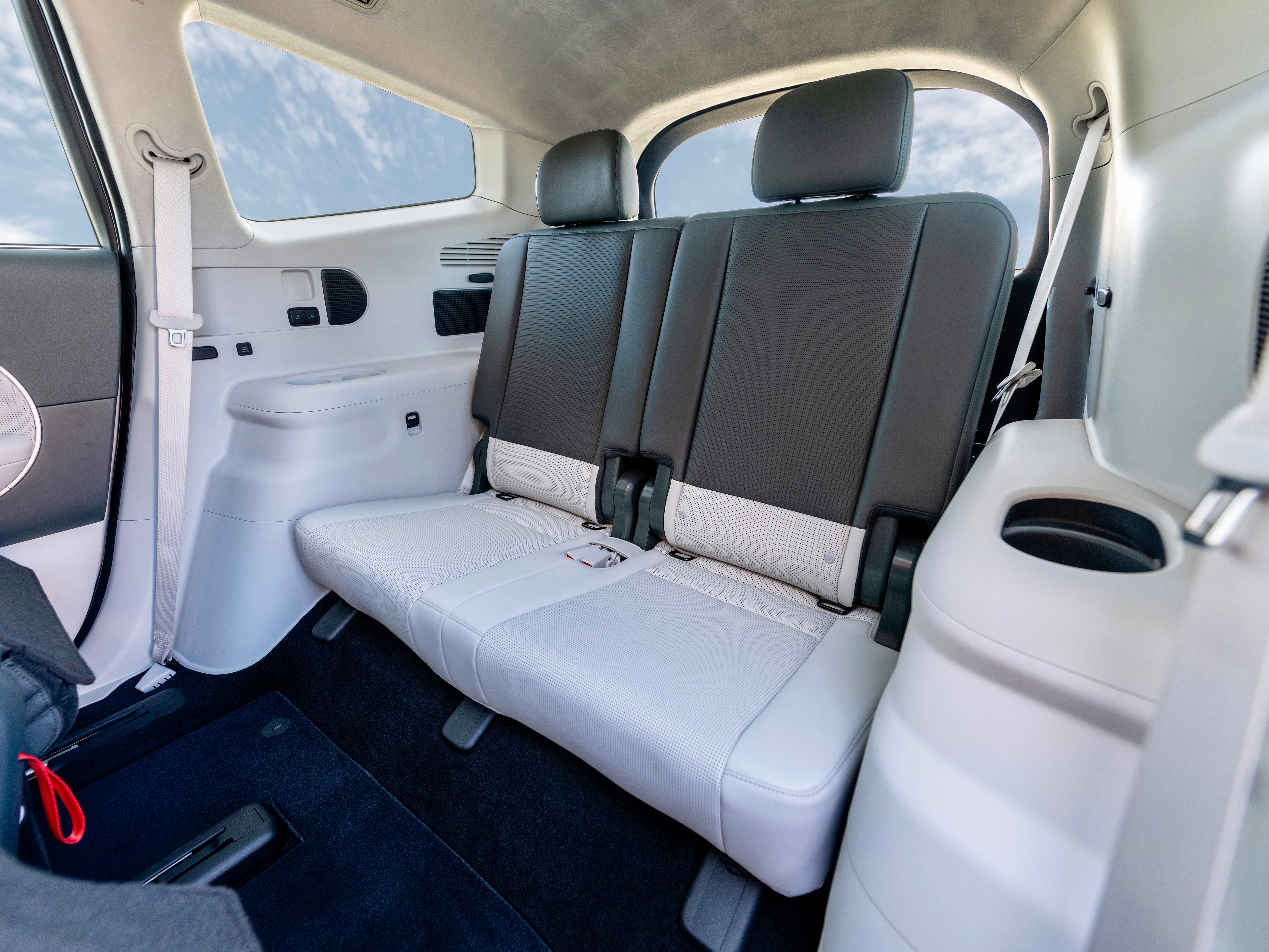
Hyundai Ioniq 9 rivals:
FAQs
How does Hyundai Ioniq 9 compare to the Kia EV6?
The Ioniq 9 and EV6 both share the same E-GMP platform. This means they use the same 800-volt electrical system and plenty of other bits, but the Hyundai gets a larger battery with more range and lots of other technical updates that will probably make their way through to the Kia EV9 when that car is updated probably in 2026. The Hyundai is actually slightly longer than the Kia, although it doesn’t look it. Cruciall, the Ioniq 9 gets a slight price advantage over the EV9, too.
How much does it cost - is it worth it?
The Ioniq 9 is an expensive car, but it lives up to that price with its quality, kit and the way it drives. It starts at £64,995 and goes up to £78.595.
Does Hyundai replace batteries for free?
As with all EVs, the Ioniq 9 battery will be covered for eight years and 100,000 miles, while Hyundai still has its impressive five-year warranty on the car as a whole.
Why trust us
Our team of motoring experts have decades of experience driving, reviewing and reporting on the latest EV cars, and our verdicts are reached with every kind of driver in mind. We thoroughly test drive every car we recommend, so you can be sure our verdicts are honest, unbiased and authentic.
The verdict: Hyundai Ioniq 9
The Ioniq 9 is a hugely impressive car – I loved it. It feels like an EV9 with the benefit of hindsight, which is exactly what it is. So it feels slightly more comfortable on the road, will go further on a charge, feels even more premium and – crucially – undercuts its Kia cousin. It has got plenty of space for seven and their luggage on board, and we really liked the way the car drove. It’s impressively quiet and rode over the bumps during our UK test really well. If you’re after a seven-seat family car – or just a premium car with comfort to the fore – the Hyundai Ioniq 9 is one of our favourite EVs.







